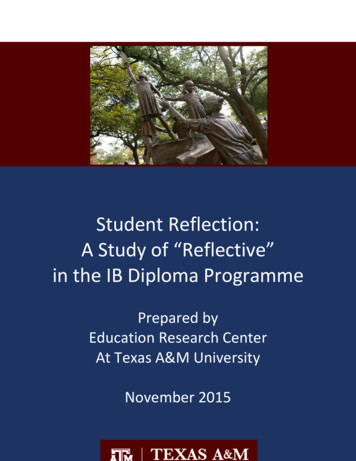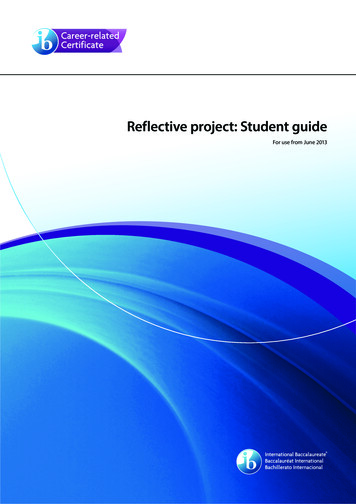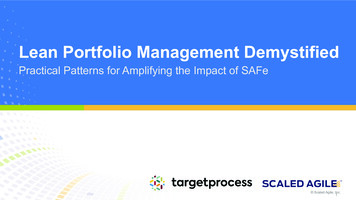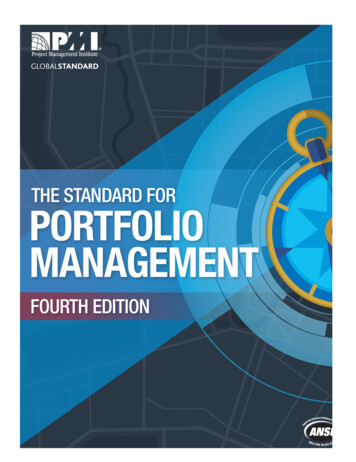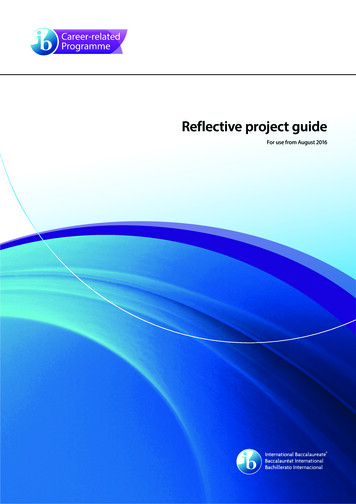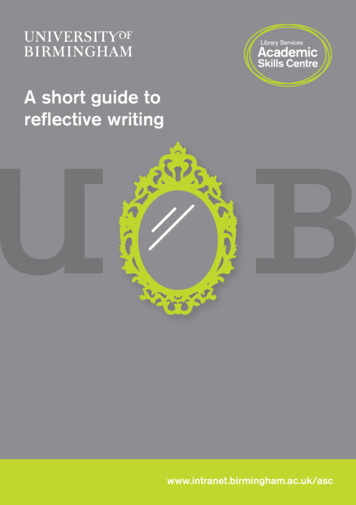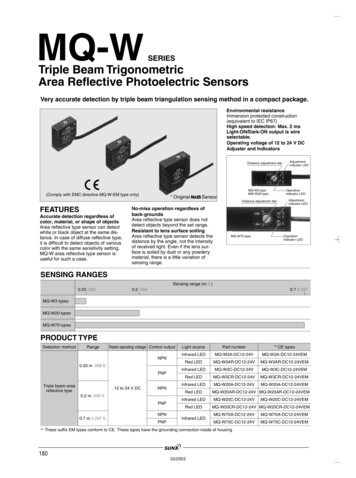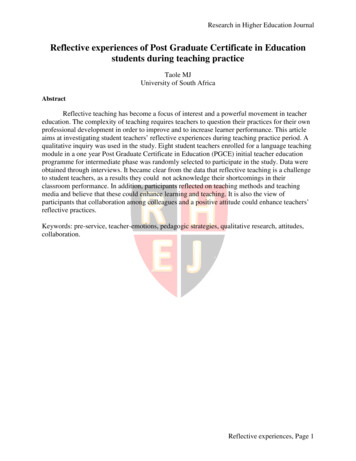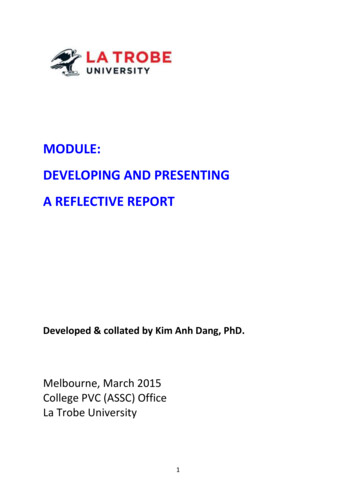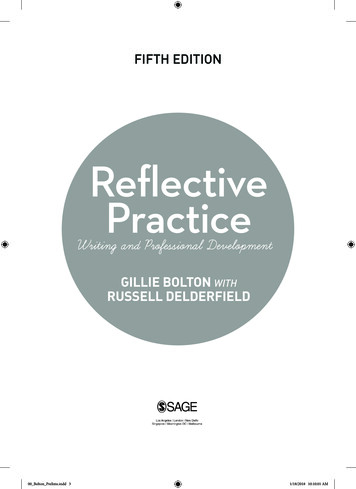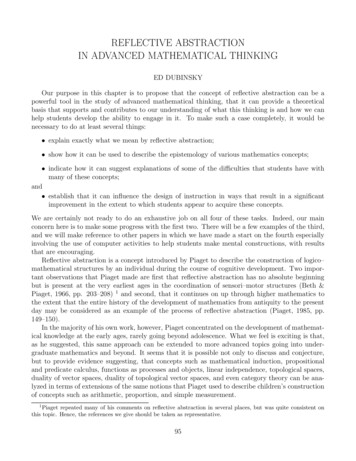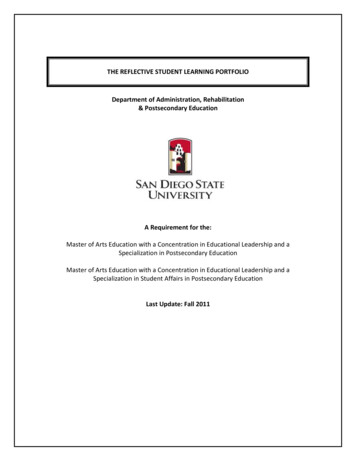
Transcription
THE REFLECTIVE STUDENT LEARNING PORTFOLIODepartment of Administration, Rehabilitation& Postsecondary EducationA Requirement for the:Master of Arts Education with a Concentration in Educational Leadership and aSpecialization in Postsecondary EducationMaster of Arts Education with a Concentration in Educational Leadership and aSpecialization in Student Affairs in Postsecondary EducationLast Update: Fall 2011
TABLE OF CONTENTSPAGEINTRODUCTION . . 3PART 1: THE REFLECTIVE STUDENT LEARNING PORTFOLIO . 4Purpose of the Portfolio . 5Goals of the Portfolio Process . 5Contents of the Portfolio . 6Required Artifacts to be Included in the Portfolio . 7Pre‐Assessment of Learning . 7First Year Learning . 8Second Year Learning . 10Summary of Learning/Post‐Assessment . 12Organization of the Portfolio. 14Disposition of the Portfolio . 15PART 2: ORAL DEFENSE OF THE PORTFOLIO . 16Formal Oral Presentation Procedures . 16The Portfolio Review Committee . 16Students’ Responsibilities. 16REFERENCES. . 17APPENDIX A: Reflective Student Learning Portfolio Checklist. . 18APPENDIX B: Questions to Consider in Preparation for the OralPresentation. .21[2]
THE REFLECTIVE LEARNING PORTFOLIOINTRODUCTIONThis document describes the important components of the reflective learning portfolio.The reflective learning portfolio is a degree requirement for all students in the Master ofArts Education with a Concentration in Educational Leadership and a Specialization inPostsecondary Education1 program and the Master of Arts Education with aConcentration in Educational Leadership and a Specialization in Student Affairs inPostsecondary Education program2. The portfolio is part of the final appraisal of thecandidate's completion of the graduate program, and the formal presentation of theportfolio is used to demonstrate the culminating learning experience in the program.Students who choose to complete a reflective learning portfolio will not be required todo a written comprehensive exam or complete a research thesis. Additionally, students,who have elected to do a written comprehensive exam or a research thesis are requiredto complete a reflective learning portfolio requirement in accordance with program, butare not required to complete the formal presentation.This handbook contains two parts:Part 1 The reflective learning portfolio: a description of the portfolio and its evaluationPart 2 Formal oral presentation of the portfolio: identification of the procedures to beused for the formal oral presentation of the portfolio12Typically referred to as the “PSE program”Typically referred to as the “Student Affairs program”[3]
PART 1: THE REFLECTIVE LEARNING PORTFOLIOPurpose of the PortfolioThe purpose of the portfolio is to demonstrate a reflective record of professional growthover time. It is to showcase samples of "best work" at a given point in the student’sacademic career. It serves as a demonstration of attainment of course and programgoals, desired outcomes, and advanced skills. It is a celebration of efforts.Portfolios are intended to demonstrate a broad repertoire of candidate performanceover time. They are intended to paint a rich, developmental view of the professionalgrowth and accomplishments of a candidate. One purpose of using portfolios in theoverall program appraisal process is that the portfolio process moves the individual to aprofessional level of personal responsibility. Candidates become adept at examiningtheir own growth and communicating their thinking to others. Portfolios are intendedto convey information not only on one's accomplishments, but also on developmentalefforts, and areas in need of continued improvement.The portfolio prepares students for future job interviews or entrance interviews tograduate school, as the content and quality of all work in the portfolio are current,relevant, and ready to share while revealing a candidate's capability for jobperformance.The portfolio is a performance‐based component of candidate appraisal at thecompletion of the graduate program. The portfolio focuses on the candidate’sperformance in the program, as well as the prerequisite knowledge with which thecandidate entered. It provides a way for the candidate to document his/her learningexperiences and reflect upon professional growth. Each candidate is required tomaintain a portfolio that will serve as a communication and assessment tool inconversations with the program faculty and with prospective employers and graduateschools.The portfolio process adopted by the ARPE department follows a model set forth inZubizarreta’s (2004) work. According to Zubizarreta, the learning portfolio— groundedin a process of reflection, evidence, and collaboration— is a rich, flexible document thatengages students in continuous, thoughtful analysis of their learning. The portfolio maybe paper, electronic, or another creative medium, but at its center, the power of writingand reflection combine in the portfolio with purposeful, selective collection andassessment of learning endeavors, and outcomes to improve learning. Morespecifically,the learning portfolio (1) provides direct evidence of the quality of a student'swork and a basis for evaluation of work‐in‐progress, (2) defines assessment as aprocess, rather than necessarily as "final"; it permits re‐evaluation by alternativeevaluators, at different times and in different contexts (different from providing[4]
final quantitative grades), and (3) empowers the student to self‐assess andcontinuously expand or otherwise improve her/his work (University ofWashington, 2003, ¶ 2).Further, the portfolio process allows the student to highlight their developmentallearning abilities by, (1) demonstrating their mastery of the program learning outcomesor major points of the program, (2) providing evidence of how the work on anassignment evolved (3) choosing which artifacts (e.g., assignments, projects, workssamples, reflection of internship experiences, etc.) best represent their learning in andoutside the classroom (4) choosing artifacts that show improvement in theircompetencies and abilities throughout their enrollment in the program, (5) linkingtheories with applied learning experiences (6) self‐analyzing and reflecting on their ownlearning, (7) using a wide range of digital and multimedia technologies to demonstratetechnical competency, design, and presentation skills, (8) being more proactive inplanning and pursuing their educational and post‐graduate opportunities; and (9)demonstrating their competencies and capabilities as they pursue career choices(University of Washington, 2003, ¶ 3).Originally, the sole purpose of the reflective learning portfolio for this program was todemonstrate the educational journey of the student. While this reason still holds truefor this portfolio process, changes to federal policy and the zeitgeist of higher educationhave resulted in the portfolio’s movement towards demonstration of the “value‐added”by the educational degree at San Diego State University.Goals of the Portfolio ProcessWhen writing your reflective learning portfolio, a good place to begin is reflection uponthe goals of the portfolio process, which are described—in part—below. Because theportfolio is a purposeful and self‐reflective collection of a student’s work generatedduring the process of completing graduate course work, each student’s portfolio should: Serve as a translation of graduate student performance standards and learningoutcomes through the demonstration of authentic artifacts (e.g., examples thatillustrate what the student has learned and can do). Provide an integrated performance‐based picture of how well the candidate hasperformed throughout the program and how the candidate can communicatethe results of learning. Show the growth and learning accomplished as demonstrated through thestudent's early pieces of work and later pieces of work. Illustrate the student’s ability to synthesize her/his learning of theory and itsapplication to practice over a period of time.[5]
Contents of the PortfolioApart from the pre‐assessment and post‐assessment materials, your portfolio willconsist of the following items for each course: (1) an artifact of learning for the course(some work product that you believe best illustrates your learning), and (2) a reflectionpaper on the chosen artifact.Since the portfolio is a reflection of your learning and performance, to some extent, theportfolio contents will be individualized to reflect the student’s personalized learningexperience. Yet, since a sampling of portfolios will be used to evaluate programeffectiveness, a format has been prescribed to ensure appropriate learning artifacts areincluded, and therefore evaluated in order to inform program improvements.Instructional seminars will be offered throughout your program to assist you withcompiling your learning portfolio. In some cases, these informational sessions may alsobe presented to you in group advising meetings.As mentioned, the portfolio may contain written products, photographs, videotapes,posters, and notes from a meeting. Generally, portfolios include both work in‐progressand best efforts. The portfolio must include a wide range of selected work artifacts overtime that document the actual achievement of learning outcomes. The artifacts youselect are to be examples of "best" efforts. Here are some examples of what might beincluded as artifacts: ReportsProducts undertaken as part of course work, including internships andindependent researchArtifacts from your graduate assistantshipsAction research undertakenDocumentation of presentations madeDocumentation of implementation of skills into work situationsProducts producedPublished articlesComputer software createdLetters of commendationPictures/art workResume documenting committee assignments or new professional experiencePersonal reflection logs and journalsTestimonials or evidence of your effectiveness from your constituentsOutcomes‐based assessment reports from your projectsExamples of professional growth endeavors (conference, workshop, or seminarparticipation)Self‐assessment tests or exercisesConference proposals and presentationsPerformance evaluations[6]
Required Artifacts to be Included in the PortfolioAlthough students’ experiences in the program differ greatly, the faculty require someconsistency in artifact selection so that portfolios can be used to evaluate studentlearning in the program. Candidates need to present their portfolios in a logical mannerso that the learning can be easily interpreted, not only by the program faculty but by thepotential employer and/or graduate school admission committee.The following are required sections for the portfolio. Each section lists requireddocuments or artifacts of learning. Checklists for each section can be found on theprogram website.Pre‐Assessment of LearningThe purpose of this section is to demonstrate what you knew prior to enrolling in thisdegree program. Within this section, you will illustrate your perception of theprofession and your preparedness for the profession.This section must include the following materials:1. A copy of your program admission application materials (if you do not have acopy of these materials, they can be obtained from your admissions file at theARPE office).2. A copy of your academic transcript prior to entering the program.3. A copy of your resume prior to entering the program.4. The completed pre‐assessment evaluation distributed at Orientation. Thisdocument can also be found on the program website at:http://interwork.sdsu.edu/main/ma student affairs/rlp5. A 2‐4 page reflection paper3 that addresses the following question: How does mycurrent academic and professional training prepare me to meet the expectedlearning outcomes of this program?6. Your informal academic program plan (this document outlines when you plan totake program courses). While it is not your official academic plan, this documentshould outline the courses you plan to take to complete your degree and shouldbe organized by which semester you plan to take them. A typical academic plancan be found on the program website at:http://interwork.sdsu.edu/main/postsecondary leadership/requirements for PSE students3All reflection papers must be formatted in accordance to APA guidelines and include a title page.[7]
or http://interwork.sdsu.edu/main/ma student affairs/current for Student Affairsstudents.The pre‐assessment portion of the portfolio should be completed and submitted to yourfaculty advisor. The deadline for this submission is typically in October of your firstsemester, and will be set by the Program Coordinator. Electronic submissions or papersubmissions of the pre‐assessment materials are welcomed. The program faculty willreview the pre‐assessment documents and return them to the students. If anyclarification is required, the students will be notified at the time they meet with theirfaculty advisor.First Year LearningThe purpose of this section is to demonstrate what you learned during the first year ofthe program. It is due upon completion of two semesters of study. This section mustinclude the following materials:1. An Artifact of Learning for Each Completed Course: For each class that you takeduring your first year, you must select an artifact that will best represent thelearning outcomes for the course as they relate to the program learningoutcomes. Be mindful that course instructors may advise the use of a particularartifact. In addition to inclusion of the artifact of learning, you must write a 1‐2page reflection paper for each artifact that addresses the following questions:oooooooWhat is the artifact (briefly describe the artifact)?Why did I select this artifact to demonstrate my learning in this course?What course learning outcomes does this artifact demonstrate?What program learning outcomes does this artifact demonstrate?How does this artifact demonstrate my pursuit of my professional goals4?How does this artifact demonstrate my pursuit of my personal goals5?What recommendations do I have for improving the course?2. An Artifact of Out‐of‐Class Learning: Since the program requires the integrationof student learning from in class with learning that takes place in the field, youare required to include an artifact of learning from outside of class for eachsemester enrolled in the program (excluding summer terms). Such an artifactmight be a report written for your work or a project that was enhanced becauseof your application of learning from the program. In addition to the artifact oflearning, you must draft a 1‐2 page reflection paper that addresses the followingquestions:o What is the artifact (briefly describe the artifact)?45Please reference the professional goals you indicated on the pre‐assessment evaluation.Please reference the personal goals you indicated on the pre‐assessment evaluation.[8]
o Why did I select this artifact to demonstrate my application of learning inpractice?o What program learning outcomes does this artifact demonstrate?o How does this artifact demonstrate my pursuit of my professional goals?o How does this artifact demonstrate my pursuit of my personal goals?3. A Summary of Learning in the First Year: You must write a 2‐4 page reflectionpaper in which you summarize your learning from the first year in the program.In doing so, please reflect on two key items:o Achievement of Program Learning Outcomes: Consider the extent towhich you have achieved the program learning outcomes, and thecoursework and professional development experiences that haveenabled you to achieve them. In addition, consider the program learningoutcomes you have yet to achieve. Finally, reflect upon whatexperiences, actions, and opportunities you can pursue in the secondyear of the program to meet any unmet outcomes. If necessary, reviseyour academic plan and/or your professional goals. Be sure to addressthe following questions in your reflection paper: Which of the program learning outcomes have I achieved and bywhat means (e.g., courses, assignments, workshops, seminars,etc.) did I achieve them? Which of the program learning outcomes have I not yet achieved? What learning and/or professional development opportunities doI need to pursue in the next year to ensure I achieve all of theprogram learning outcomes? (e.g., how do I plan to meet theunmet learning outcomes?)o Achievement of Personal and Professional Goals: Consider the extent towhich you have achieved the personal and professional goals youarticulated in the pre‐assessment section of the portfolio. In doing so,reflect upon the coursework and professional development experiencesthat have facilitated your achievement of these goals. Be sure to addressthe following questions in your reflection paper: How (if at all) my personal or professional goals changed becauseof what I am learning in this program? Am I on target to achieve my personal and professional goalsbased on my learning in this program thus far? What learning and/or professional development opportunities doI need to pursue in the next year to ensure I achieve my personaland professional goals? (e.g., how do I plan to meet the unmetgoals?)[9]
4. A Revised Academic Plan: If your academic plans have changed, submit a revisedplan.5. Revised Personal and Professional Goals: Submit a revised set of personal and/orprofessional goals if they have changed from what you initially articulated in thepre‐assessment section of the portfolio.6. An Updated Resume: Submit an updated resume that includes new professionalexperiences and skills obtained during your first year in the program.The first year portion of the portfolio is typically due at the beginning of your thirdsemester of study (e.g., the fall semester of your second year). A deadline forcompletion and submission to your advisor will be set by the Program Coordinator.Electronic or paper submissions of the portfolio are welcomed, and will be reviewed byfaculty advisors. Please note: if you plan to submit your final portfolio in electronic form,you may wish design your website, and post your first year portfolio materials. This willgive your faculty member an opportuni
by the educational degree at San Diego State University. Goals of the Portfolio Process When writing your reflective learning portfolio, a good place to begin is reflection upon the goals of the portfoli
